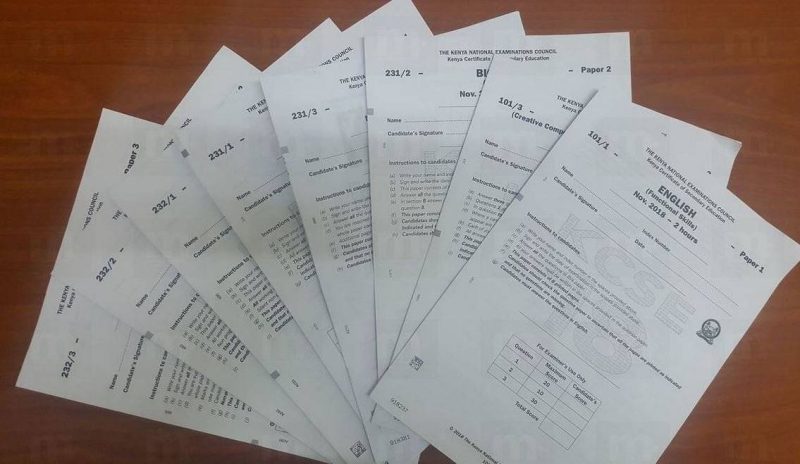- INSTRUCTIONS TO CANDIDATES
Both paper 1%2 consists of three sections: A,B and C
Candidates are expected to answer ALL Questions in Section A in Both paper 1&2. However, in section B and C we expect candidates to answer at least three and two questions respectively. All instructions given to candidates must be read in both paper 1&2.
- TIME
A History and Government candidate must strictly adhere to the set time guideline of 2 Hours and 30 Minutes as required in both paper 1&2. Failure to observe time may disorient a candidate in the last minutes to collection of scripts. It is therefore recommended that the below time guide be used by candidates to avoid last minute rush in answering questions.
| Item | Writing of Identities and Prayer | Section A | Section B | Section C | Total time |
| Time | 5 minutes | 45minutes | 60 minutes | 40 minutes | 2:30 Min. |
Read and download more free history resources below; Educationnewshub.co.ke:
History Paper 1 Topic By Topic Questions And Answers
HISTORY NOTES FORM 2: NEW SYLLABUS SIMPLIFIED NOTES
HISTORY NOTES FORM 3: NEW SYLLABUS SIMPLIFIED NOTES
History & Government notes and exams for forms 1, 2, 3 and 4 free downloads
HISTORY NOTES FORM 4: NEW SYLLABUS SIMPLIFIED NOTES
HISTORY NOTES FORM ONE: NEW SYLLABUS SIMPLIFIED NOTES
HISTORY NOTES FORM 1-4: COMPLETE HISTORY NOTES
History Paper 2 Topic By Topic Questions And Answers (All Topics)
History and Government free lesson plans for all topics (Form one to four)

- COURSE OUTLINE FOR HISTORY AND GOVERNMENT
This chapter embodies a clear picture of both paper one and two from Form 1-4 with the intent of enlightening candidates on specific topics of coverage per paper. In respect to this, there are topics that do appear in both papers. Below is a table of course outline for both paper one and two.
| 311/1
PAPER ONE |
311/2
PAPER TWO |
| 1.Introduction to History and Govt
2.The Peoples of Kenya up to 19th Century 3.Social, Economic and Political Organization of Kenyan Communities 4.Contacts between East Africa and the outside world 5.Citizenship 6.National Integration 7.Constitutions and Constitution Making 8.Democracy and Human Rights 9.Establishment of Colonial Rule in Kenya 10.Social and Economic Developments in Kenya during colonial period 11.Political developments and the struggle for Independence in Kenya 12.Lives and Contributions of Kenyan Leaders 13.Formation, structure and functions of the Govt of Kenya 14.Social, Economic and Political Developments and challenges in Kenya since Independence 15.National Philosophies 16.Devolved Government 17.Public Revenue and expenditure
|
1.Introduction to History and Govt
2.The Early Man 3.Development of Agriculture 4.Trade 5.Transport 6.Communication 7.Development of Industry 8.Urbanisation 9.Social, Political and Economic organization of African Societies 10.Constitutions and constitution making-sources of British Constitution 11.Democracy and Human Rights 12.European invasion and the process of colonization of Africa 13.Colonial Administration 14.Rise of African Nationalism 15. World Wars 1&2 16.International Relations 17.Cooperation in Africa 18. Social, Economic and Political Developments and challenges in Africa since Independence. 19. The Electoral process, functions of governments in other parts of the World. -Britain -USA -India |
- ANALYSIS OF PAPER 311/1-2017
Section A (25 Marks)
In this section, ALL paper one topics are set sequentially from Form 1-4. Candidates must have a sound knowledge of the entire paper one areas of the syllabus. All questions are structured and thus require distinctive answers.
Section B (45 Marks)
Read the following topics in preparation for this year’s Examinations.
- The Peoples of Kenya up to 19th Century
- Social, Economic and Political Organization of Kenyan Communities.
- Contacts between East Africa and the outside World.—Portuguese
—Christian Missionaries
- Social and economic developments in Kenya during colonial period—Settler Farming
—Land Policies
- Political developments and the struggle for Independence in Kenya
—independent schools and churches
—early political associations
—role of women
Section C (30 Marks)
- National Philosophies
- Formation,structure and functions of the govt of Kenya:
a)Judiciary—superior courts in Kenya
—Functions of the Chief Justice KCSE 2015
—ways through which Independence of Judiciary is guaranteed KCSE 2012
—composition of Judicial Service Commission KCSE 2012
—Problems facing Judiciary KCSE 2015
b)Executive—Powers and privileges of President
—qualifications of election as President KCSE 2014
—Functions of IEBC KCSE 2013
—-Categories of KDF KCSE 2012 & KCSE 2016
—Challenges facing KDF
—Reasons for voting in Kenya –KCSE 2016
—Why General elections are important kcse 2011
- c) Legislature—principle of separation of powers btw the three arms of govt—legislature,judiciary and executive 2016
—Functions of the National Assembly
—Functions of the Senate Assembly
—Functions of speakers of Senate and the National Assembly
- Constitutions and constitution making —Features of the Independence constitution
–Features of the constitution of Kenya 2010.KCSE 2014
- Social, Economic and Political Developments and challenges in Kenya since Independence—Multiparty democracy
—Achievements of multiparty democracy in Kenya
- Devolved government—Functions of County Executive Committee
—composition of County Executive Committee
— Challenges faced by county governments
—Funtions of governor
—functions/roles of county governments
- National Integration
- citizenship
- ANALYSIS OF PAPER 311/2-2017
- Section A (25 Marks)
In this section, ALL paper one topics are set sequentially from Form 1-4. Candidates must have a sound knowledge of the entire paper one areas of the syllabus. All questions are structured and thus require distinctive answers.
- Section B (45 Marks)
- Development of Agriculture—Agrarian Revolution in USA and Britain
—factors, Invention and effects
- Trade —Trans-Atlantic trade, role of middlemen, How the trade contributed to rise of Kingdoms in West Africa/western sudan, problems of transatlantic trade, factors for the rise of transatlantic trade and finall effects.
- Transport —Effects of various means of transport more so modern means.
- Development of industry—Factors for the rise of urban centres. Problems facing various urban centres. Reasons for the decline of Meroe.
- Shona—Social, Economic and political organization
- European colonization—factors for colonization. Berlin conference. Impacts of partitioning of Africa
- Rise of African Nationalism—Ghana, South Africa and the least expected is Mozambique.
- Section C (30 Marks)
- Colonial Administration —Indirect Rule in Nigeria-WHY IT FAILED IN S. NIGERIA, WHY IT SUCCEEDED IN N.NIGERIA
- Social, Economic and Political Developments and challenges in Africa since Independence—Tanzania
- FIRST AND SECOND WORLD WARS
- Cooperation in Africa—EAC
—ECOWAS
—COMESA
- The Electoral process, functions of governments in other parts of the World.
-Britain
-USA
- NON-ALLIGNED MOVEMENT
The main objective of this paper is to help candidates in their day to day preparations for KCSE. This paper is essential to teachers and students of History.

